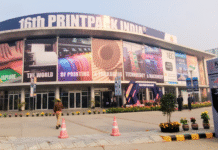AIMPLAS, the plastics technology center, is participating in the EcoFILLink project, which is coordinated by the Instituto de Tecnología Cerámica (ITC) and financed by the Valencian Institute of Business Competitiveness (IVACE) through the European Regional Development Fund (ERDF). The project aims to reduce the environmental impact generated by ink containers used for digital decoration of ceramic tiles.
Waste from plastic containers contaminated with ink-jet inks currently amounts to 500 tonnes per year and a volume of 10,650 cubic meters. Recycling these containers is a problem due to their complexity and the dirt released on contact with water, since 5% of the ink remains adhered to the container internal walls, representing losses of EUR 3.6 million (approximately Rs 32 crore) per year.
The EcoFILLink project aims to implement eco-design strategies in packaging and waste management in accordance with the circular economy. To achieve this, several eco-design techniques will be implemented to make packaging reusable at least five times. To this end, the packaging will be redesigned to improve interior washing, and internal functions will be included to maximize emptying by 2 to 5%. The project also provides for the recovery of valuable inks and other materials from the cleaning water that can then be added to ceramic materials, thus resulting in the use of 2 million euros in ink.
And when the containers can no longer be reused, recycling treatments for contaminated plastics will be optimized using supercritical CO 2 to reduce the impact of the recycling process and the waste generated.
These measures will be implemented in collaboration and partnership with stakeholders
throughout the value chain. The specific participating companies are: Pamesa Cerámica, S.L.; Cottocer, S.L.; Compacglass, S.L.; Keramex, S.A.; TAU Porcelánico, S.L.; Colorobbia España, S.A.; Ravi iniciativas medioambientales, S.L.U.; Rolplas S.L.; Acteco productos y servicios, S.L.; Alcion Plásticos Solutions S.L.; and Plastire S.A.
ITC-AICE and AIMPLAS are aware of the importance of designing a new plastic container for storage and transport of ink-jet inks that minimizes its environmental impact through the implementation of different eco-design strategies for containers and waste management in line with the circular economy to ensure that resources remain in the economy as long as possible.
EcoFILLink aims to have a positive impact on the three forms of sustainable development –
environmental, economic, and social development. It is aligned with the objectives established by the United Nations (UN) in Agenda 2030.
At AIMPLAS, the Plastics Technology Centre, our mission is twofold: to provide companies with added value so they can create wealth and meet societal challenges to improve people’s quality of life and ensure environmental sustainability. It supports the 17 SDGs of the UN Global Compact when carrying out its work and corporate social responsibility activities.
It is a non-profit research association and member of REDIT (Network of Technological Institutes of the Valencia Region) that offers companies in the plastics industry comprehensive, customized solutions, including development and innovation projects, training, and competitive and strategic intelligence, and technological services such as analysis, testing and technical assistance.
















